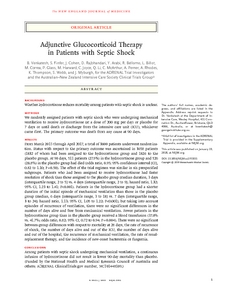Venkatesh, B;
Finfer, S;
Cohen, J;
Rajbhandari, D;
Arabi, Y;
Bellomo, R;
Billot, L;
Correa, M;
Glass, P;
Harward, M;
et al.
Venkatesh, B; Finfer, S; Cohen, J; Rajbhandari, D; Arabi, Y; Bellomo, R; Billot, L; Correa, M; Glass, P; Harward, M; Joyce, C; Li, Q; McArthur, C; Perner, A; Rhodes, A; Thompson, K; Webb, S; Myburgh, J; ADRENAL Trial Investigators and the Australian–New Zealand Inten
(2018)
Adjunctive Glucocorticoid Therapy in Patients with Septic Shock.
N Engl J Med, 378.
pp. 797-808.
ISSN 1533-4406
https://doi.org/10.1056/NEJMoa1705835
SGUL Authors: Rhodes, Andrew
![[img]](http://sgultest.da.ulcc.ac.uk/109578/1.hassmallThumbnailVersion/Venkatesh.pdf)  Preview |
|
PDF
Published Version
Available under License ["licenses_description_publisher" not defined].
Download (308kB)
| Preview
|
Abstract
Background Whether hydrocortisone reduces mortality among patients with septic shock is unclear. Methods We randomly assigned patients with septic shock who were undergoing mechanical ventilation to receive hydrocortisone (at a dose of 200 mg per day) or placebo for 7 days or until death or discharge from the intensive care unit (ICU), whichever came first. The primary outcome was death from any cause at 90 days. Results From March 2013 through April 2017, a total of 3800 patients underwent randomization. Status with respect to the primary outcome was ascertained in 3658 patients (1832 of whom had been assigned to the hydrocortisone group and 1826 to the placebo group). At 90 days, 511 patients (27.9%) in the hydrocortisone group and 526 (28.8%) in the placebo group had died (odds ratio, 0.95; 95% confidence interval [CI], 0.82 to 1.10; P=0.50). The effect of the trial regimen was similar in six prespecified subgroups. Patients who had been assigned to receive hydrocortisone had faster resolution of shock than those assigned to the placebo group (median duration, 3 days [interquartile range, 2 to 5] vs. 4 days [interquartile range, 2 to 9]; hazard ratio, 1.32; 95% CI, 1.23 to 1.41; P<0.001). Patients in the hydrocortisone group had a shorter duration of the initial episode of mechanical ventilation than those in the placebo group (median, 6 days [interquartile range, 3 to 18] vs. 7 days [interquartile range, 3 to 24]; hazard ratio, 1.13; 95% CI, 1.05 to 1.22; P<0.001), but taking into account episodes of recurrence of ventilation, there were no significant differences in the number of days alive and free from mechanical ventilation. Fewer patients in the hydrocortisone group than in the placebo group received a blood transfusion (37.0% vs. 41.7%; odds ratio, 0.82; 95% CI, 0.72 to 0.94; P=0.004). There were no significant between-group differences with respect to mortality at 28 days, the rate of recurrence of shock, the number of days alive and out of the ICU, the number of days alive and out of the hospital, the recurrence of mechanical ventilation, the rate of renal-replacement therapy, and the incidence of new-onset bacteremia or fungemia. Conclusions Among patients with septic shock undergoing mechanical ventilation, a continuous infusion of hydrocortisone did not result in lower 90-day mortality than placebo. (Funded by the National Health and Medical Research Council of Australia and others; ADRENAL ClinicalTrials.gov number, NCT01448109 .).
| Item Type: |
Article
|
| Additional Information: |
From New England Journal of Medicine, Venkatesh, B; Finfer, S; Cohen, J; Rajbhandari, D; Arabi, Y; Bellomo, R; Billot, L; Correa, M; Glass, P; Harward, M; et al. Adjunctive Glucocorticoid Therapy in Patients with Septic Shock, 378, 797-808. Copyright © (2018) Massachusetts Medical Society. Reprinted with permission. |
| Keywords: |
General & Internal Medicine, 11 Medical And Health Sciences |
| SGUL Research Institute / Research Centre: |
Academic Structure > Molecular and Clinical Sciences Research Institute (MCS) |
| Journal or Publication Title: |
N Engl J Med |
| ISSN: |
1533-4406 |
| Language: |
eng |
| Dates: |
| Date | Event |
|---|
| 1 March 2018 | Published | | 19 January 2018 | Published Online | | 18 December 2017 | Accepted |
|
| Publisher License: |
Publisher's own licence |
| PubMed ID: |
29347874 |
 |
Go to PubMed abstract |
| URI: |
http://sgultest.da.ulcc.ac.uk/id/eprint/109578 |
| Publisher's version: |
https://doi.org/10.1056/NEJMoa1705835 |
Statistics
Item downloaded times since 01 Feb 2018.
Actions (login required)
 |
Edit Item |



